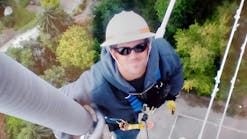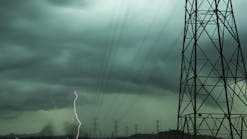Just outside of Utica, New York, transmission and distribution line workers at the New York Power Authority (NYPA) sharpen their climbing, rigging and emergency rescue skills as part of their yearly certification training. The high-voltage line workers are part of an elite team of professionals and members of IBEW Local 2032.
All line personnel who help maintain the statewide electrical transmission system for NYPA must consistently show that they are proficient in their ability to rescue themselves or others in case of an emergency. The recertification process involves demonstrating their rigging and rescue techniques as they climb utility poles, towers and lattice structures, and operate aerial lifts.
It is all part of NYPA’s ongoing focus on safety and training to help protect line workers who work with wires carrying up to 765 kV, while contending with long hours on the road, severe weather and safety requirements.
Reviewing Tools and Procedures
The government-mandated five-day safety course, which takes place at NYPA’s Clark Energy Center, includes a blend of classroom instruction, field training and exercises on transmission structures in a state-of-the-art training yard.
In the classroom, instructors inspect all climbing equipment, keep all line personnel up to date with Occupational Safety and Health Administration (OSHA) regulations and NYPA procedures, review in detail any new tools for the trade, and recertify with personal protective equipment such as insulating rubber gloves and sleeves. Protective grounding procedures are also reviewed annually.
Practicing Rescue Techniques
Outside in the 20-acre training yard, line workers recertify climbing and practice hurt-man rescue on full-scale towers, poles and lattice structures, which are also used to prepare linemen to do other types of work in a de-energized environment. The line instructor evaluates and times rescue techniques with a focus on safety.
To replicate an actual emergency situation, the linemen take a 165-lb lead-weighted rescue dummy up a structure and place it in a precarious position. Another team stands below to guide secondary lifelines to ensure against a fall. The trainers then time how long it takes for each lineman to climb the tower, rescue the dummy and get it down to the ground using block and tackle rigging techniques.
All line workers also must recertify on all aerial lifts, truck and JLG platform lifts. As part of this process, each lineman is timed as they go up on the lift and rappel down on a rope.
Linemen know there are no second chances in this business. If they don’t get it right the first time, it might be their last. An emergency situation requires a quick response when they’re maintaining high-power transmission and distribution lines.
Overall industry mortality rates used to be high, but fortunately, increased safety measures have improved those odds considerably. In NYPA’s case, there has not been a fatal line accident since the St. Lawrence Power Project started generating electricity in 1958. NYPA continues to maintain a rigorous lineman training program, and safety is prioritized daily. ♦
Peter Sheedy is the technical instructor for the line department for transmission and distribution training for the New York Power Authority (NYPA). He has worked in the industry for the past 40 years. Before joining NYPA, he worked as a journeyman, chief hot stick lineman and line supervisor/instructor.



